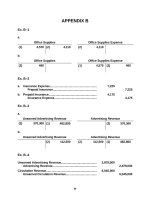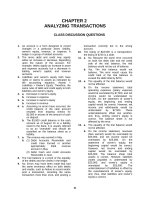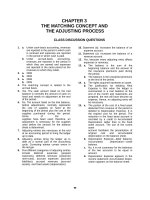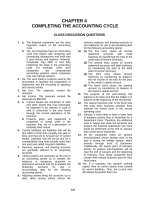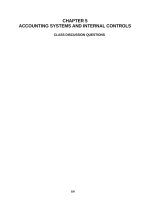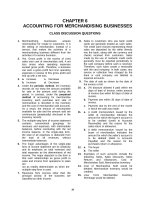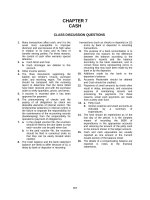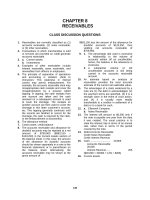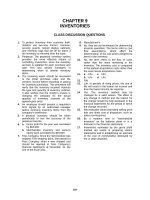Solution manual accounting 21e by warreni ch 11
Bạn đang xem bản rút gọn của tài liệu. Xem và tải ngay bản đầy đủ của tài liệu tại đây (277.78 KB, 51 trang )
CHAPTER 11
CURRENT LIABILITIES
CLASS DISCUSSION QUESTIONS
1. To match revenues and expenses properly,
the liability to cover product warranties
should be recorded in the period during
which the sale of the product is made.
2. When the defective product is repaired, the
repair costs would be recorded by debiting
Product Warranty Payable and crediting
Cash, Supplies, or another appropriate
account.
3. Yes. Since the $5,000 is payable within one
year, Company A should present it as a
current liability at September 30.
4. a. Income or withholding taxes, social
security, and Medicare
b. Employees Income Tax Payable, Social
Security Tax Payable, and Medicare
Tax Payable
5. There is a ceiling on (a) the social security
portion of the FICA tax and (d) federal
unemployment compensation tax.
6. The deductions from employee earnings
are for amounts owed (liabilities) to others
for such items as federal taxes, state and
local income taxes, and contributions to
pension plans.
7. Yes. Unemployment compensation taxes
are paid by the employer on the first $7,000
of annual earnings for each employee.
Therefore, hiring two employees, each
earning $12,500 per year, would require the
payment of twice the unemployment tax
than if only one employee, earning
$25,000, was hired.
8. 1. c
2. c
3. a
4. b
5. b
9. The use of special payroll checks relieves
the treasurer or other executives of the task
of signing a large number of regular checks
each payday. Another advantage of this
system is that reconciling the regular bank
statement is simplified. The paid payroll
checks are returned by the bank separately
from regular checks and are accompanied by a
statement of the special bank account. Any
balance shown on the bank's statement will
correspond to the sum of the payroll
checks outstanding because the amount of
each deposit is exactly the same as the
total amount of checks drawn.
10. a. Input data that remain relatively
unchanged from period to period (and
therefore do not need to be
reintroduced into the system frequently)
are called constants.
b. Input data that differ from period to
period are called variables.
11. a. If employees’ attendance records are
kept and their preparation supervised
in such a manner as to prevent errors
and abuses, then one can be assured
that wages paid are based on hours
actually worked. The use of “In” and
“Out” cards, whereby employees
indicate by punching a time clock their
time of arrival and departure, is
especially
useful.
Employee
identification cards or badges can be
very helpful in giving additional
assurance.
b. The requirement that the addition of
names on the payroll be supported by
written
authorizations
from
the
Personnel Department can help ensure
that payroll checks are not being
issued
to
fictitious
persons.
Endorsements on payroll checks can
be compared with other samples of
employees' signatures.
12. If the vacation payment is probable and
can be reasonably estimated, the vacation
pay expense should be recorded during the
period in which the vacation privilege is
earned.
13. Employee life expectancies, expected
employee retirement dates, employee
turnover, employee compensation levels,
and invest-ment income on pension
contributions are factors that influence the
future pension obligation of an employer.
251
EXERCISES
Ex. 11–1
Current liabilities:
Federal income taxes payable............................................................
Advances on magazine subscriptions..............................................
Total current liabilities........................................................................
1
2
$ 42,0001
155,2502
$197,250
$120,000 × 35%
6,900 × $30 × 9/12 = $155,250
The nine months of unfilled subscriptions are a current liability because Web
World received payment prior to providing the magazines.
Ex. 11–2
a.
1. Merchandise Inventory.............................................
Interest Expense.......................................................
Notes Payable......................................................
196,000
4,0001
2. Notes Payable...........................................................
Cash.....................................................................
200,000
b. 1. Notes Receivable......................................................
Sales....................................................................
Interest Revenue.................................................
200,000
2. Cash..........................................................................
Notes Receivable................................................
200,000
1
$200,000 × 8% × 90/360
200,000
200,000
196,000
4,000
200,000
Ex. 11–3
a. $90,000 × 6% × 90/360 = $1,350 for each alternative.
b. (1) $90,000 simple-interest note: $90,000 proceeds
(2) $90,000 discounted note: $90,000 – $1,350 interest = $88,650 proceeds
c. Alternative (1) is more favorable to the borrower. This can be verified by
comparing the effective interest rates for each loan as follows:
Situation (1): 6% effective interest rate
($1,350 × 360/90) ÷ $90,000 = 6%
Situation (2): 6.09% effective interest rate
($1,350 × 360/90) ÷ $88,650 = 6.09%
The effective interest rate is higher for the second loan because the creditor
lent only $88,650 in return for $1,350 interest over 90 days. In the simpleinterest loan, the creditor must lend $90,000 for 90 days to earn the same
$1,350 interest.
Ex. 11–4
a.
Accounts Payable..........................................................
Notes Payable...........................................................
b. Notes Payable................................................................
Interest Expense............................................................
Cash..........................................................................
9,000
9,000
9,000
75*
9,075
*$9,000 × 5% × 60/360 = $75
Ex. 11–5
a. June
b. Dec.
c. June
30 Building.........................................................
Land...............................................................
Note Payable............................................
Cash.........................................................
730,000
250,000
31 Note Payable.................................................
Interest Expense ($800,000 × 8% × 1/2)......
Cash.........................................................
40,000
32,000
30 Note Payable.................................................
Interest Expense ($760,000 × 8% × 1/2).......
Cash.........................................................
40,000
30,400
800,000
180,000
72,000
70,400
Ex. 11–6
a. $4,650,000, or the amount disclosed as the current portion of long-term debt.
b. By the end of 2002, the bank credit line was reduced to $299,000; thus, the
bank credit line was nearly paid off in 2002. The difference between the
$34,783,000 that would be due in the coming period and the $4,650,000
disclosed as the current portion must have been funded (i.e., replaced) by
long-term notes payable. Indeed, of the $50 million increase in the term loans
($95 million – $45 million), around $35 million must have been used to
eliminate the bank credit line.
c. The current liabilities declined by $4,351,000 ($4,650,000 – $299,000).
Ex. 11–7
a.
Product Warranty Expense (2% × $750,000)................
Product Warranty Payable.......................................
15,000
b. Product Warranty Payable.............................................
Wages Payable.........................................................
Supplies....................................................................
960
15,000
570
390
Ex. 11–8
a.
The warranty liability represents estimated outstanding automobile warranty
claims. Of these claims, $14,166 million is estimated to be due during 2003,
while the remainder ($9,125 million) is expected to be paid after 2003. The
distinction between short-term and long-term liabilities is important to
creditors in order to accurately evaluate the near-term cash demands on the
business, relative to the quick assets and other longer-term demands.
b. Product Warranty Expense............................ 14,881,000,000
Product Warranty Payable.......................
14,881,000,000
$20,410 + X – $12,000 = $23,291
X
= $23,291 – $20,410 + $12,000
X
= $14,881 million
c. The liability might have grown for a number of possible reasons. Often the
estimated warranty liability will increase if the underlying product sales are
also increasing, as was the case for Ford during this time. Alternatively,
Ford’s actual claims experience might be declining. If the percent of sales
estimate remained unchanged, this would cause the liability to potentially
increase. This partially explains the increase, since only $12,000 million in
claims were assumed to be paid, while the current estimated claims payable
was $13,605 million at December 31, 2001. Lastly, Ford could be increasing its
estimated warranty claims expense as a percent of current period sales.
Ex. 11–9
a.
Damage Awards and Fines............................................
670,000
EPA Fines Payable....................................................
390,000
Litigation Claims Payable........................................
280,000
Note to Instructors: The “damage awards and fines” would be disclosed on
the income statement under “other expenses.”
b. The company experienced a hazardous materials spill at one of its plants
during the previous period. This spill has resulted in a number of lawsuits to
which the company is a party. The Environmental Protection Agency (EPA)
has fined the company $390,000, which the company is contesting in court.
Although the company does not admit fault, legal counsel believes that the
fine payment is probable. In addition, an employee has sued the company. A
$280,000 out-of-court settlement has been reached with the employee. The
EPA fine and out-of-court settlement have been accrued. There is one other
outstanding lawsuit related to this incident. Counsel does not believe that the
lawsuit has merit. Other lawsuits and unknown liabilities may arise from this
incident.
Ex. 11–10
a.
Adjusting entry to accrue litigation contingency, 12/31/01:
Litigation Expenses and Losses.............................
Contingent Product and Tort Claims Payable...
219,100,000
219,100,000
Note to Instructors: The actual titles in the accounts may vary from those
illustrated in this answer and, in practice, will vary according to the nature of
the contingency.
b. Summary journal entry to pay claims in 2002:
Contingent Product and Tort Claims Payable........
Cash.....................................................................
75,000,000
75,000,000
c. A liability must be recognized if the contingency is both estimable and
probable. The note makes it clear that the claims have been ongoing across
thousands of cases. This means it is possible to reasonably estimate the
losses from the historical litigation experience. That is, the average loss per
case could be determined and applied to the outstanding cases. In addition, a
portion of the claim losses are known to be probable, again based upon past
experience.
Ex. 11–11
a.
Regular pay (40 hrs. × $18)........................................
Overtime pay (10 hrs. × $27)......................................
Gross pay....................................................................
$720
270
$990
b.
Gross pay....................................................................
Less: Social security tax (6.0% × $990)...................
Medicare tax (1.5% × $990).............................
Federal withholding........................................
Net pay.........................................................................
$990.00
$ 59.40
14.85
185.00
259.25
$730.75
Ex. 11–12
Consultant
Computer
Programmer
Administrator
Regular earnings.................................. $2,500.00
Overtime earnings................................
Gross pay.............................................. $2,500.00
$1,600.00
360.00
$1,960.00
$ 800.00
120.00
$ 920.00
Less: Social security tax..................... $
0.001
Medicare tax...............................
37.50
Federal income tax withheld 4....
570.15
$ 607.65
Net pay.................................................. $1,892.35
66.002
29.40
435.64
$ 531.04
$1,428.96
$
$
55.203
13.80
111.64
$ 180.64
$ 739.36
1
Gross pay exceeds $100,000, so there is no social security tax withheld.
[($100,000 – $98,900) × 6%] = $66.00
3
$920 × 6.0% = $55.20
4
The federal income tax withheld is determined from applying the calculation
procedure associated with Exhibit 3, as follows:
2
Withholding calculations:
Consultant
$ 2,500.00
– 463.76
$ 2,036.24
×
28%
$ 570.15
Computer
Programmer
$1,960.00
– 404 .14
$1,555.86
×
28%
$ 435.64
Administrator
$
–
$
×
$
920.00
473.46
446.54
25%
111.64
Ex. 11–13
a.
Summary: (1) $224,800; (3) $269,000; (8) $4,460; (12) $75,800
Details:
Net amount paid.....................................................
Total deductions....................................................
(3) Total earnings........................................................
Overtime.................................................................
(1) Regular...................................................................
$189,000
80,000
$269,000
44,200
$224,800
Total deductions....................................................
Social security tax.................................................
Medicare tax...........................................................
Income tax withheld...............................................
Medical insurance..................................................
Union dues.............................................................
$ 15,730
4,035
47,915
7,860
Total earnings........................................................
Factory wages........................................................
Office salaries........................................................
(12) Sales salaries.........................................................
$135,400
57,800
(8)
$ 80,000
$
$269,000
b. Factory Wages Expense................................................
Sales Salaries Expense.................................................
Office Salaries Expense................................................
Social Security Tax Payable.....................................
Medicare Tax Payable...............................................
Employees Income Tax Payable..............................
Medical Insurance Payable......................................
Union Dues Payable.................................................
Salaries Payable.......................................................
135,400
75,800
57,800
c.
189,000
Salaries Payable.............................................................
Cash..........................................................................
75,540
4,460
193,200
$ 75,800
15,730
4,035
47,915
7,860
4,460
189,000
189,000
d. The amount of social security tax withheld, $15,730, is $410 less than 6.0% of
the total earnings of $269,000. This indicates that the cumulative earnings of
some employees exceed $100,000. Therefore, it is unlikely that this payroll
was paid during the first few weeks of the calendar year.
Ex. 11–14
Opry Sounds does have an internal control procedure that should detect the
payroll error. Before funds are transferred from the regular bank account to the
payroll account, the owner authorizes a voucher for the total amount of the
week's payroll. The owner should catch the error, since the extra 360 hours will
cause the weekly payroll to be substantially higher than usual.
Ex. 11–15
a. Inappropriate. Access to the check-signing machine should be restricted.
b. Appropriate. The use of a special payroll account assists in preventing fraud
and makes it easier to reconcile the company's bank accounts.
c. Appropriate. All changes to the payroll system, including wage rate increases,
should be authorized by someone outside the Payroll Department.
d. Inappropriate. Payroll should be informed when any employee is terminated.
A supervisor or other individual could continue to clock in and out for the
terminated employee and collect the extra paycheck.
e. Inappropriate. Each employee should record his or her own time out for
lunch. Under the current procedures, one employee could clock in several
employees who are still out to lunch. The company would be paying
employees for more time than they actually worked.
Ex. 11–16
a.
Social security tax (6% × $480,000)........................................
Medicare tax (1.5% × $540,000)...............................................
State unemployment (4.3% × $12,000)....................................
Federal unemployment (0.8% × $12,000)................................
b. Payroll Taxes Expense..................................................
Social Security Tax Payable.....................................
Medicare Tax Payable...............................................
State Unemployment Tax Payable...........................
Federal Unemployment Tax Payable.......................
$28,800
8,100
516
96
$37,512
37,512
28,800
8,100
516
96
Ex. 11–17
Tip Top Stores Inc. should not compute and report payroll taxes according to its
fiscal year. Rather, employers are required to compute and report all payroll taxes
on the calendar-year basis, regardless of the fiscal year they may use for financial
reporting purposes. Thus, social security and FUTA maximum earnings
limitations apply to the calendar-year payroll.
Ex. 11–18
Vacation Pay Expense...................................................
Vacation Pay Payable ($165,120 × 1/12)..................
13,760
13,760
Ex. 11–19
a. Dec.
b. Jan.
31 Pension Expense..........................................
Unfunded Pension Liability....................
315,000
15 Unfunded Pension Liability..........................
Cash.........................................................
315,000
315,000
315,000
Ex. 11–20
The $1,032 million unfunded pension liability is the approximate amount of the
pension obligation that exceeds the value of the accumulated net assets of the
pension plan. Apparently, Procter & Gamble has underfunded its plan relative to
the actuarial obligation that has accrued over time. This can occur when the
company contributes less to the plan than the annual pension cost.
The obligation grows yearly by the amount of the periodic pension cost. Thus, the
periodic pension cost is an actuarial measure of the amount of pension earned by
employees during the year. The annual pension cost is determined by making
actuarial assumptions about employee life expectancies, employee turnover,
expected compensation levels, and interest.
Ex. 11–21
a.
Quick Ratio =
Quick Assets
Current Liabilities
December 31, 2005:
$530,000 $350,000
= 1.10
$800,000
December 31, 2006:
$356,000 $400,000
= 0.84
$900,000
b. The quick ratio has been decreased between the two balance sheet dates. The
major reason is a significant increase in inventory. Cash also declined,
possibly to purchase the inventory. As a result, quick assets actually
declined, while the current liabilities increased. While the quick ratio for
December 31, 2006, is below 1.0, it is not yet at an alarming level. However,
the trend suggests that the firm’s current asset (working capital) management
should be watched closely.
Ex. 11–22
a.
Apple Computer Inc.
Dell Computer Corp.
2.96
0.81
Quick Ratio
Quick Ratio =
Quick Assets
Current Liabilities
Apple Computer Inc.:
Quick ratio =
$5,388 $45 $441
= 2.96
$1,658
Dell Computer Corp.:
Quick ratio =
$8,924 $306 $1,394
= 0.81
$8,933
b. It is clear that Apple Computer’s short-term liquidity is stronger than Dell’s.
Apple’s quick ratio is 215% higher. Apple has a much stronger relative cash
and short-term investment position than does Dell. Apple’s cash and shortterm investments are 80% of total current assets (261% of current liabilities),
compared to Dell’s 52% of total current assets (52% of current liabilities). In
addition, Dell’s relative accounts payable position is larger than Apple’s,
indicating the possibility that Dell has longer supplier payment terms than
does Apple. A quick ratio of 2.96 for Apple suggests ample flexibility to make
strategic investments with its excess cash, while a quick ratio of 0.81 for Dell
indicates an efficient but tight quick asset management policy.
PROBLEMS
Prob. 11–1A
1.
Feb. 15 Merchandise Inventory.........................................
Accounts Payable—Ranier Co.......................
30,000
30,000
Mar. 17 Accounts Payable—Ranier Co............................
Notes Payable..................................................
30,000
Apr. 16 Notes Payable.......................................................
Interest Expense ($30,000 × 30/360 × 5%)...........
Cash.................................................................
30,000
125
July 15 Cash......................................................................
Notes Payable..................................................
40,000
25 Tools......................................................................
Interest Expense ($45,000 × 120/360 × 7%).........
Notes Payable..................................................
43,950
1,050
Oct. 13 Notes Payable.......................................................
Interest Expense ($40,000 × 90/360 × 6%)..........
Notes Payable..................................................
Cash.................................................................
40,000
600
Nov. 12 Notes Payable.......................................................
Interest Expense ($40,000 × 30/360 × 9%)..........
Cash.................................................................
40,000
300
22 Notes Payable.......................................................
Cash.................................................................
45,000
1 Office Equipment..................................................
Notes Payable..................................................
Cash.................................................................
80,000
17 Litigation Loss......................................................
Litigation Claims Payable...............................
41,000
31 Notes Payable.......................................................
Interest Expense ($6,000 × 8% × 30/360)............
Cash.................................................................
6,000
40
Dec.
30,000
30,125
40,000
45,000
40,000
600
40,300
45,000
60,000
20,000
41,000
6,040
Prob. 11–1A
2.
Concluded
a. Product Warranty Expense......................................
Product Warranty Payable..................................
15,680
b. Interest Expense.......................................................
Interest Payable...................................................
($6,000 × 8% × 30/360 × 9 = $360)
360
15,680
360
Prob. 11–2A
1. a. Dec. 30 Sales Salaries Expense................................
Warehouse Salaries Expense......................
Office Salaries Expense...............................
Employees Income Tax Payable.............
Social Security Tax Payable...................
Medicare Tax Payable.............................
Bond Deductions Payable......................
Group Insurance Payable.......................
Salaries Payable......................................
185,300
47,800
74,900
b. Dec. 30 Payroll Taxes Expense.................................
Social Security Tax Payable...................
Medicare Tax Payable.............................
State Unemployment Tax Payable..........
Federal Unemployment Tax Payable......
22,722
1
2
4
b. Jan.
6
185,300
47,800
74,900
55,440
18,480
4,620
10,780
17,556
201,124
$308,000 × 6%
$308,000 × 1.5%
5 Payroll Taxes Expense.................................
Social Security Tax Payable...................
Medicare Tax Payable.............................
State Unemployment Tax Payable..........
Federal Unemployment Tax Payable......
5
17,402
4,620
588
112
$14,000 × 4.2%
$14,000 × 0.8%
2. a. Dec. 30 Sales Salaries Expense................................
Warehouse Salaries Expense......................
Office Salaries Expense...............................
Employees Income Tax Payable.............
Social Security Tax Payable...................
Medicare Tax Payable.............................
Bond Deductions Payable......................
Group Insurance Payable.......................
Salaries Payable......................................
3
55,440
17,402
4,620
10,780
17,556
202,202
$308,000 × 4.2%
$308,000 × 0.8%
38,500
18,480
4,620
12,936
2,464
Prob. 11–3A
1.
Employee
Gross
Earnings
Federal Income
Tax Withheld
Social Security
Tax Withheld
Medicare
Tax Withheld
Alvarez
Carver
Felix
Lydall
Porter
Song
Walker
$124,200
6,000
40,800
22,000
102,000
36,000
58,800
$31,050
900
6,528
3,850
24,480
6,480
11,172
$ 6,000*
360
2,448
1,320
6,000*
2,160
3,528
$21,816
$1,863
90
612
330
1,530
540
882
$5,847
*$100,000 maximum × 6%
2.
a. Social security tax paid by employer...........................................
$21,816
b. Medicare tax paid by employer.....................................................
5,847
c. Earnings subject to unemployment compensation tax,
$7,000 for all employees except Carver, who has only
$6,000 in gross earnings. Thus, total earnings subject
to SUTA and FUTA are [(6 × $7,000) + $6,000].
State unemployment compensation tax: $48,000 × 4.2%...........
2,016
d. Federal unemployment compensation tax: $48,000 × 0.8%.......
384
e. Total payroll taxes expense..........................................................
$30,063
Prob. 11–4A
1. 2006
Dec.
2. Dec.
3. Dec.
4. Dec.
12 Sales Salaries Expense................................
Office Salaries Expense...............................
Delivery Salaries Expense...........................
Social Security Tax Payable...................
Medicare Tax Payable.............................
Employees Income Tax Payable.............
Medical Insurance Payable.....................
Salaries Payable......................................
3,366.50
2,900.00
1,959.00
12 Salaries Payable...........................................
Cash.........................................................
5,737.33
12 Payroll Taxes Expense.................................
Social Security Tax Payable...................
Medicare Tax Payable.............................
State Unemployment Tax Payable..........
Federal Unemployment Tax Payable......
671.91
15 Employees Income Tax Payable..................
Social Security Tax Payable.........................
Medicare Tax Payable...................................
Cash.........................................................
1,402.06
987.06
246.76
493.53
123.38
1,402.06
469.20
5,737.33
5,737.33
493.53
123.38
45.00
10.00
2,635.88
Prob. 11–5A
1.
PAYROLL FOR WEEK ENDING December 7, 2006
Earnings
Total
Name Hours Regular Overtime
M
N
O
P
Q
R
S
T
U
2.
45.00
25.00
1,120.00
550.00
40.00
40.00
46.00
40.00
720.00
800.00
740.00
640.00
50.00 1,440 .00
6,010 .00
210.00
Total
1,330.00
550.00
2,350.00
720.00
800.00
166.50
906.50
640.00
1,000.00
540 .00 1,980.00
916.50 10,276 .50
Social
Security
Tax
Medicare
Tax
79.80
33.00
0.00
43.20
48.00
54.39
38.40
60.00
118.80
475 .59
19.95
8.25
35.25
10.80
12.00
13.60
9.60
15.00
29.70
154 .15
Sales Salaries Expense.................................................
Office Salaries Expense................................................
Social Security Tax Payable.....................................
Medicare Tax Payable...............................................
Employees Federal Income Tax Payable................
Bond Deductions Payable.......................................
Salaries Payable.......................................................
Deductions
Federal
U.S.
Income Savings
Tax
Bonds
292.60
82.50
564.00
144.00
168.00
190.37
121.60
215.00
455 .40
2,233.47
35.00
50.00
15.00
10.00
15.00
40 .00
165 .00
Paid
Total
Net
Amount
Ck.
No.
427.35
902.65 818
123.75
426.25 819
649.25 1,700.75 820
213.00
507.00 821
238.00
562.00 822
258.36
648.14 823
184.60
455.40 824
290.00
710.00 825
643 .90 1,336 .10 826
3,028.21 7,248.29
6,926.50
3,350.00
475.59
154.15
2,233.47
165.00
7,248.29
Accounts
Sales
Salaries
Expense
Debited
Office
Salaries
Expense
1,330.00
550.00
2,350.00
720.00
800.00
906.50
640.00
1,000.00
1,980.00
6,926.50
3,350.00
Prob. 11–6A
1.
Dec.
2 Bond Deductions Payable...................................
Cash.................................................................
2,400
3 Social Security Tax Payable.................................
Medicare Tax Payable...........................................
Employees Federal Income Tax Payable............
Cash.................................................................
8,276
2,178
13,431
14 Operations Salaries Expense..............................
Officers Salaries Expense....................................
Office Salaries Expense.......................................
Social Security Tax Payable...........................
Medicare Tax Payable.....................................
Employees Federal Income Tax Payable.......
Employees State Income Tax Payable...........
Bond Deductions Payable..............................
Medical Insurance Payable.............................
Salaries Payable..............................................
42,500
18,500
11,000
14 Salaries Payable...................................................
Cash.................................................................
48,204
14 Payroll Taxes Expense.........................................
Social Security Tax Payable...........................
Medicare Tax Payable.....................................
State Unemployment Tax Payable..................
Federal Unemployment Tax Payable..............
5,396
17 Social Security Tax Payable.................................
Medicare Tax Payable...........................................
Employees Federal Income Tax Payable............
Cash.................................................................
7,920
2,160
12,816
18 Medical Insurance Payable..................................
Cash.................................................................
9,000
2,400
23,885
3,960
1,080
12,816
3,240
1,200
1,500
48,204
48,204
3,960
1,080
285
71
22,896
9,000
Prob. 11–6A
Continued
Dec. 28 Operations Salaries Expense..............................
Officers Salaries Expense....................................
Office Salaries Expense.......................................
Social Security Tax Payable...........................
Medicare Tax Payable.....................................
Employees Federal Income Tax Payable.......
Employees State Income Tax Payable...........
Bond Deductions Payable..............................
Salaries Payable..............................................
43,200
18,200
11,400
28 Salaries Payable...................................................
Cash.................................................................
50,343
28 Payroll Taxes Expense.........................................
Social Security Tax Payable...........................
Medicare Tax Payable.....................................
State Unemployment Tax Payable..................
Federal Unemployment Tax Payable..............
5,231
30 Bond Deductions Payable...................................
Cash.................................................................
2,400
30 Employees State Income Tax Payable................
Cash.................................................................
19,584
31 Pension Expense..................................................
Cash.................................................................
Unfunded Pension Liability............................
50,000
2.
Dec. 31 Operations Salaries Expense..............................
Officers Salaries Expense....................................
Office Salaries Expense.......................................
Salaries Payable..............................................
31 Vacation Pay Expense..........................................
Vacation Pay Payable......................................
3,931
1,092
12,958
3,276
1,200
50,343
50,343
3,931
1,092
166
42
2,400
19,584
46,000
4,000
4,320
1,820
1,140
7,280
13,200
13,200
Prob. 11–6A
Continued
This solution is applicable only if the P.A.S.S. Software that accompanies the text
is used.
BROWNIE POINTS GIFTS INC.
Income Statement
For the Period Ended December 31, 20—
Sales...................................................................................
Cost of merchandise sold.................................................
Gross profit........................................................................
Operating expenses:
Selling expenses:
Operations salaries expense...............................
Advertising expense............................................
Depreciation expense—store equipment...........
Store supplies expense.......................................
Miscellaneous selling expense...........................
Total selling expenses....................................
Administrative expenses:
Officers salaries expense....................................
Office salaries expense........................................
Rent expense........................................................
Heating and lighting expense..............................
Insurance expense...............................................
Miscellaneous administrative expense...............
Payroll taxes expense..........................................
Pension expense..................................................
Vacation pay expense..........................................
Total administrative expenses........................
Total operating expenses...........................................
Net loss..............................................................................
$ 3,771,200
1,646,000
$ 2,125,200
100.00
43.65
56.35
$ 1,036,020
47,100
13,041
36,926
9,050
$ 1,142,137
27.47
1.25
0.35
0.98
0.24
30.29
$
11.76
7.16
1.98
0.79
0.73
0.18
3.55
1.33
0.35
27.81
58.10
(1.74)
443,320
269,940
74,500
29,650
27,551
6,800
133,871
50,000
13,200
$ 1,048,832
$ 2,190,969
$ (65,769)
Prob. 11–6A
Continued
BROWNIE POINTS GIFTS INC.
Statement of Owner’s Equity
For the Period Ended December 31, 20—
Marco Woo, capital (beginning of period)........................
Net loss..............................................................................
Plus withdrawals................................................................
Decrease in capital............................................................
Marco Woo, capital (end of period)..................................
$715,759
$ 65,769
150,000
215,769
$499,990
Prob. 11–6A
Concluded
BROWNIE POINTS GIFTS INC.
Balance Sheet
December 31, 20—
Assets
Cash......................................................................................
Accounts receivable............................................................
Merchandise inventory........................................................
Prepaid insurance................................................................
Store supplies......................................................................
Total current assets........................................................
Store equipment...................................................................
Accumulated depreciation—store equipment..............
Total plant assets.......................................................
Total assets...........................................................................
Liabilities
Accounts payable.................................................................
Salaries payable...................................................................
Social security tax payable..................................................
Medicare tax payable............................................................
Employees federal income tax payable..............................
State unemployment tax payable........................................
Federal unemployment tax payable....................................
Medical insurance payable..................................................
Unfunded pension liability...................................................
Vacation pay payable...........................................................
Total liabilities.................................................................
$ 30,074
188,203
281,627
4,050
7,825
$ 511,779
$ 162,300
(44,980)
117,320
$ 629,099
$ 78,061
7,280
7,862
2,184
12,958
1,651
413
1,500
4,000
13,200
$ 129,109
Owner’s Equity
Marco Woo, capital...............................................................
499,990
Total liabilities and equity....................................................
$ 629,099
Prob. 11–1B
1.
Apr.
7 Cash......................................................................
Notes Payable..................................................
20,000
May 10 Equipment.............................................................
Interest Expense ($90,000 × 120/360 × 8%).........
Notes Payable..................................................
87,600
2,400
June 6 Notes Payable.......................................................
Interest Expense ($20,000 × 60/360 × 6%)...........
Notes Payable..................................................
Cash.................................................................
20,000
200
July
6 Notes Payable.......................................................
Interest Expense ($20,000 × 30/360 × 9%)...........
Cash.................................................................
20,000
150
Aug. 3 Merchandise Inventory.........................................
Accounts Payable—Hamilton Co...................
18,000
Sept. 2 Accounts Payable—Hamilton Co........................
Notes Payable..................................................
18,000
7 Notes Payable.......................................................
Cash.................................................................
90,000
1 Notes Payable.......................................................
Interest Expense ($18,000 × 60/360 × 7.5%)........
Cash.................................................................
18,000
225
15 Store Equipment...................................................
Notes Payable..................................................
Cash.................................................................
100,000
Dec. 15 Notes Payable.......................................................
Interest Expense ($9,000 × 6% × 30/360)............
Cash.................................................................
9,000
45
21 Litigation Loss......................................................
Litigation Claims Payable...............................
45,000
Nov.
20,000
90,000
20,000
200
20,150
18,000
18,000
90,000
18,225
63,000
37,000
9,045
45,000
Prob. 11–1B
2.
Concluded
a. Product Warranty Expense......................................
Product Warranty Payable..................................
13,900
b. Interest Expense.......................................................
Interest Payable...................................................
($9,000 × 6% × 46/360 × 6 = $414)
414
13,900
414
